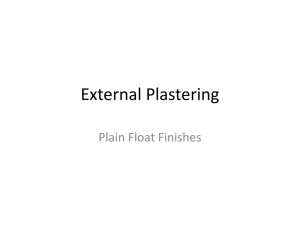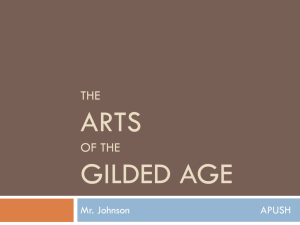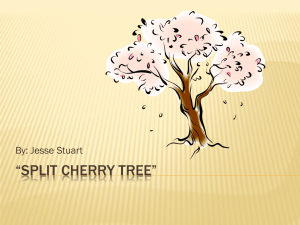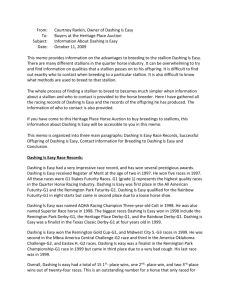Dry Dashing
advertisement
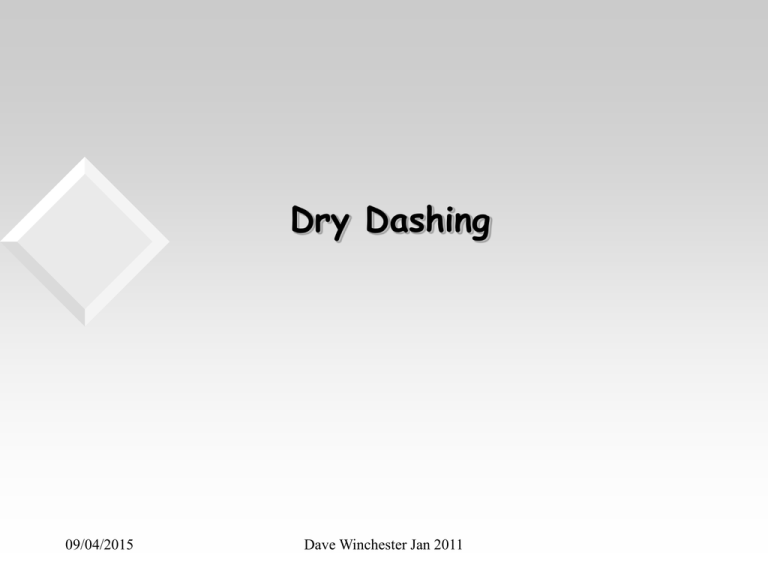
Dry Dashing 09/04/2015 Dave Winchester Jan 2011 10 thing you should know about external finishes 1 Poorly graded sand should not be used on external rendering because it results in a weak mix 2 You can test for the silt content by using a jar of water 3 To aid workability and create suction lime is often used 4 A liquid plasticiser can be used in a mix in order too aid workability 09/04/2015 Dave Winchester Jan 2011 5 A bell cast or render stop bead is used to defect water away from the building, and are fixed above the doors and window, also at the bottom of the wall above the damp proof course 6 Cement is used as a binder for external rendering 7 Ordinary Portland Cement is used for external finishes 8 Mix proportions for external rendering can be accurately measured by using buckets 9 Sand is an aggregate used in external renderings 10 A strong render must not be applied toa weak background 09/04/2015 Dave Winchester Jan 2011 Dry Dashing • Dry dash (also referred to as pebble dash or pebbledash) gives a fresh, hard-wearing, waterproof finish. • http://www.youtube.com/ watch?NR=1&v=AbYg2jmF 8tk&feature=endscreen 09/04/2015 Dave Winchester Jan 2011 Dry Dashing • If applying directly to existing brickwork /blockwork / render surface, the substrate must be brushed down to remove any friable material, algae or lichen and fungicidal wash should then be applied • Stabilising solution may be applied if required to help improve adhesion and offer uniform suction 09/04/2015 Dave Winchester Jan 2011 Dry Dashing • Install all beads and trims using approved fixings at a maximum of 300mm centres (depending on the substrate • Bellcast are formed to direct water away from the face of the wall • Bellcast may be formed without beads by using a timber former 09/04/2015 Dave Winchester Jan 2011 Dry Dashing • Lightly scratch basecoat surface of a ratio of • 4 parts sand , 1 part cement, and containing a integral Waterproofer • Using a scratch comb to provide a key for finishing coat and allow to dry. 09/04/2015 Dave Winchester Jan 2011 The correct mix for a butter coat is: Dashing 6 sand : 1Dry cement :1 lime Before applying the pebbles to the wall area leave a sheet at the base of the wall to catch the pebbles, which will fall to the ground Using a dashing paddle throw the pebbles at 90˚ to the wall, do not throw them at any other angle as this will cause an uneven appearance on the finishing surface 09/04/2015 Dave Winchester Jan 2011 Dry Dashing Second coat (butter coat It is essential that all the suction is killed off before the butter coat is applied. This will allow the pebbles to be thrown onto soft materials 09/04/2015 Dave Winchester Jan 2011 Dog toothing This is used when we cannot complete the area in a day work At the end of the day’s work cut the pebbles back in a zig zag pattern Make sure the cuts are greater than 90ºin order to get into the angle and apply the butter coat the next day 09/04/2015 Dave Winchester Jan 2011 The finished appearance of a dry dash finish will vary based on the aggregate used in conjunction with the underlying dash receiver. http://www.pebbledashing.com/pebbledashing-aggregate-colours.php 09/04/2015 Dave Winchester Jan 2011
